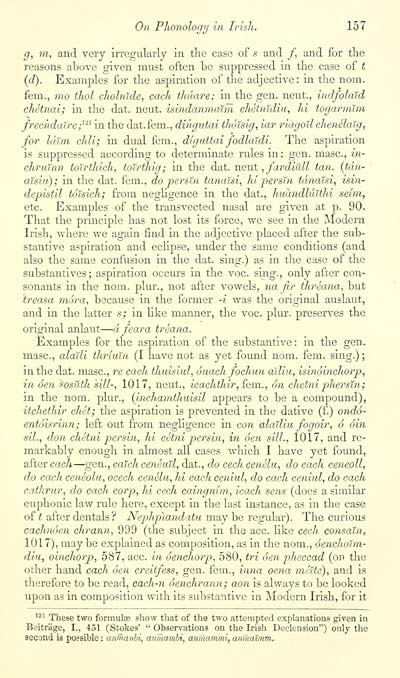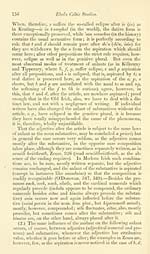Blair Collection > Celtic studies
(189)
Download files
Complete book:
Individual page:
Thumbnail gallery: Grid view | List view

On Phonologu in Irish. 157
g, m, and very irregularly in the case of s and /, and for the
reasons above given must often be suppressed in the case of t
(d). Examples for the aspiration of the adjective: in the nom.
fem., mo tJiol cJiolnide, each thiiare; in the gen. neut., indfolatd
chetnai; in the dat. neut. isindanmairil chetmdiii, hi togarmim
frechdatrc;^'^^ in the dat.fem., dingutai thmsig, iar riagoil chenelatg,
for IdXm chli; in dual fem., diguttai fodlatdi. The aspiration
is suppressed according to determinate rules in: gen. masc, in-
chruTnn toirthich, toTrthig; in the dat. neut , fardiiill tan. (tdn-
aTsiu); in the dat. fem., do persm tanaisi, hi persTn tchiaisi, isin-
depistil toisich; from neghgence in the dat., huandhitthi seim,
etc. Examples of the transvected nasal are given at p. 90.
That the principle has not lost its force, we see in the Modern
Irish, where we again find in the adjective placed after the sub-
stantive aspiration and eclipse, under the same conditions (and
also the same confusion in the dat. sing.) as in the case of the
substantives ; aspiration occui's in the voc. sing., only after con-
sonants in the nom. plur., not after vowels, na fir threana, but
treasa mora, because in the former -i was the original auslaut,
and in the latter s; in Uke manner, the voc. plur. preserves the
original anlaut — a feara treana.
Examples for the aspiration of the substantive: in the gen.
masc, alaXli thriuTn (I have not as yet found nom. fem. sing.);
in the dat. masc, re each thuisiul, onach fochun ailiii, isinoinchorp,
in den sosuth sill-, 1017, neut., icachthir,^Qxa., 6n chetni jyhersXn;
in the nom. plur., (inchamthuisil appears to be a compound),
itchethir chet; the aspiration is prevented in the dative (f.) ondd-
entnisrinn ; left ou.t from negligence in con alailiu fogoir, 6 din
sil., don chetni persin, hi cetni persin, in den sill., 1017, and re-
markably enough in almost all cases which I have yet found,
after each — gen., caTch ceneiul, dat., do cech cenelu, do each eeneoll,
do each ceneolu, ocech cenelu, hi each eeniul, do each ceniul, do each
eathrur, do each corp, hi cech eaingmm, icach sens (does a similar
euphonic law rule here, except in the last instance, as in the case
of ^ after dentals ? Nepliplandxtu maybe regular). The curious
caehnden ehrann, 999 (the subject in the ace like eeeh consain,
1017), maybe explained as composition, as in the nom., denchotm-
diu, oinehorp, 587, ace in denehorp, 580, tri den pheccad (op the
other hand each den ereitfess, gen. fem., inna oena mate), and is
therefore to be read, caeh-n denchrann; aon is always to be looked
upon as in composition with its substantive in Modern Irish, for it
'^' These two formulas show that of the two attempted explanations given in
Beitrage, I., 451 (Stokes' " Observations on the Irish Declension") only the
second is possible : anmanbi, anmambi, anihammi, anmaimm.
g, m, and very irregularly in the case of s and /, and for the
reasons above given must often be suppressed in the case of t
(d). Examples for the aspiration of the adjective: in the nom.
fem., mo tJiol cJiolnide, each thiiare; in the gen. neut., indfolatd
chetnai; in the dat. neut. isindanmairil chetmdiii, hi togarmim
frechdatrc;^'^^ in the dat.fem., dingutai thmsig, iar riagoil chenelatg,
for IdXm chli; in dual fem., diguttai fodlatdi. The aspiration
is suppressed according to determinate rules in: gen. masc, in-
chruTnn toirthich, toTrthig; in the dat. neut , fardiiill tan. (tdn-
aTsiu); in the dat. fem., do persm tanaisi, hi persTn tchiaisi, isin-
depistil toisich; from neghgence in the dat., huandhitthi seim,
etc. Examples of the transvected nasal are given at p. 90.
That the principle has not lost its force, we see in the Modern
Irish, where we again find in the adjective placed after the sub-
stantive aspiration and eclipse, under the same conditions (and
also the same confusion in the dat. sing.) as in the case of the
substantives ; aspiration occui's in the voc. sing., only after con-
sonants in the nom. plur., not after vowels, na fir threana, but
treasa mora, because in the former -i was the original auslaut,
and in the latter s; in Uke manner, the voc. plur. preserves the
original anlaut — a feara treana.
Examples for the aspiration of the substantive: in the gen.
masc, alaXli thriuTn (I have not as yet found nom. fem. sing.);
in the dat. masc, re each thuisiul, onach fochun ailiii, isinoinchorp,
in den sosuth sill-, 1017, neut., icachthir,^Qxa., 6n chetni jyhersXn;
in the nom. plur., (inchamthuisil appears to be a compound),
itchethir chet; the aspiration is prevented in the dative (f.) ondd-
entnisrinn ; left ou.t from negligence in con alailiu fogoir, 6 din
sil., don chetni persin, hi cetni persin, in den sill., 1017, and re-
markably enough in almost all cases which I have yet found,
after each — gen., caTch ceneiul, dat., do cech cenelu, do each eeneoll,
do each ceneolu, ocech cenelu, hi each eeniul, do each ceniul, do each
eathrur, do each corp, hi cech eaingmm, icach sens (does a similar
euphonic law rule here, except in the last instance, as in the case
of ^ after dentals ? Nepliplandxtu maybe regular). The curious
caehnden ehrann, 999 (the subject in the ace like eeeh consain,
1017), maybe explained as composition, as in the nom., denchotm-
diu, oinehorp, 587, ace in denehorp, 580, tri den pheccad (op the
other hand each den ereitfess, gen. fem., inna oena mate), and is
therefore to be read, caeh-n denchrann; aon is always to be looked
upon as in composition with its substantive in Modern Irish, for it
'^' These two formulas show that of the two attempted explanations given in
Beitrage, I., 451 (Stokes' " Observations on the Irish Declension") only the
second is possible : anmanbi, anmambi, anihammi, anmaimm.
Set display mode to: Large image | Transcription
Images and transcriptions on this page, including medium image downloads, may be used under the Creative Commons Attribution 4.0 International Licence unless otherwise stated. ![]()
| Early Gaelic Book Collections > Blair Collection > Celtic studies > (189) |
|---|
| Permanent URL | https://digital.nls.uk/75773462 |
|---|
| Description | A selection of books from a collection of more than 500 titles, mostly on religious and literary topics. Also includes some material dealing with other Celtic languages and societies. Collection created towards the end of the 19th century by Lady Evelyn Stewart Murray. |
|---|
| Description | Selected items from five 'Special and Named Printed Collections'. Includes books in Gaelic and other Celtic languages, works about the Gaels, their languages, literature, culture and history. |
|---|

